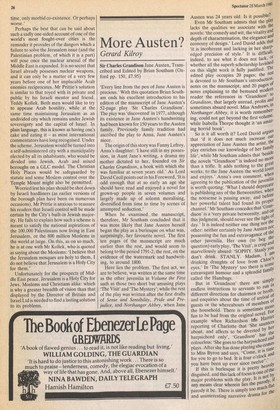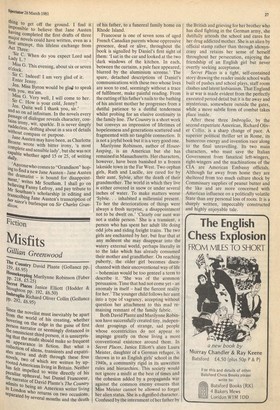More Austen?
Gerard Kilroy
Sir Charles Grandison Jane Austen, Transcribed and Edited by Brian Southam (Oxford pp. '150, £7.95) 'Every line from the pen of Jane Austen is precious.' With this quotation Brian Southam ends his excellent introduction to his edition of the manuscript of Jane Austen's 52-page play 'Sir Charles Grandison'. The play was 'discovered' in 1977, although its existence in Jane Austen's handwriting had been known for 150 years to the Austen family. Previously family tradition had ascribed the play to Anna, Jane Austen's niece.
The origin of this story was Fanny Lefroy, Anna's daughter: 'I have still in my possession, in Aunt Jane's writing, a drama my mother dictated to her, founded on Sir Charles Grandison, a book with which she was familiar at seven years old.' As Lord David Cecil points out in his Foreword, 'It is odd enough that at so early an age she should have read and enjoyed a novel for grown-up people in seven volumes and largely made up of solemn moralising, diversified from time to time by scenes of attempted seduction.'
When he examined the manuscript, therefore, Mr Southam concluded that it was more likely that Jane Austen herself began the play as a burlesque on what was, surprisingly, her favourite novel. The first ten pages of the manuscript are much earlier than the rest, and would seem to belong bathe period 1791-2; the rest, on the evidence of the watermark and handwriting, to around 1800.
Here lies the problem. The first act, we are to believe, was written at the same time as the other juvenilia in Volume the First such as those two short but amusing plays 'The Visit' and 'The Mystery'; while the rest of the play was written after the first drafts of Sense and Sensibility, Pride and Prejudice, and Northanger Abbey, when Jane Spectator 28 March 1981 Austen was 24 years old. Is it possible? Even Mr Southam admits that the plaY lacks the qualities we associate with the, novels: 'the comedy and wit, the vitality and depth of characterisation, the elegance and economy of design.' Lord David adds that it is incoherent and lacking in her shall' edged precision of style.' It is difficult, indeed, to see what it does not lack, or whether all the superb scholarship lavished on this slight work is fully justified. The edited play occupies 20 pages; the rest is devoted to Mr Southam's introduction; notes on the manuscript, and 20 pages III notes explaining to the bemused modern reader the references in `Grandison' Grandison, that largely unread, prolix ar?° sometimes absurd novel. Miss Andrews, In Northanger Abbey, it is worth remembering, could not get beyond the first volume, while Isabella Thorpe thought it 'an amazing horrid book'. So is it all worth it? Lord David argues that If it does not much increase our appreciation of Jane Austen the artist, the play enriches our knowledge of her bout)/ life', while Mr Southam admits that 'beside the novels "Grandison" is indeed no More than a trifle. It adds nothing to the great works, to the Jane Austen the world loves and enjoys.' Anna's own comment, whe.n agreeing to the publication of the juvenilia is worth quoting: 'What I should deprecate is publishing any of the Betweenities, when the nonsense is passing away, and before her powerful talent had found. its proper channel.' Mr Southam concedes that 'Gran* dison' is a 'very private betweenity, and Olif this judgment, should never see the light o sot°. day.' It is indeed neither one thing nor the other: neither certainly by Jane Austen orIr possessing the fun and extravagance of the other juvenilia. Her own (to beg question) early play, The Visit', is crisp an marvellously absurd: `SOPHY. StanlY Y°n don't drink. STANLY. Madam, 8,°: drinking draughts of love from Chloe eyes.' In 'The Mystery' too there is: extravagant humour and a splendid fainilY called the Humbugs. But in `Grandison' there are simP.IY endless instructions to servants to run In different directions for chairmen or broth; and enquiries about the time of arrival or; guests or the whereabouts of members o' the household. There is sometimes lo°1! fun to be had from the original novel. FO't example when Richardson htls Hartle, reporting of Charlotte that 'She saunter', about, and affects to be diverted by harpsichord only', `Grandison' has tric:, 'She has done playingharpsichord anal, % pcolaloysurle After she playing she CO to Miss Byron and says, "Come, it is tint° rn.
for you to go to bed. It is four o'clock, an you have been up ever since twelve • 1 If this is burlesque it is pretty hea,vti,eY disguised, and this lack of focus is one 0' I„," major problems with the play. It is not any means clear wherein lies the par°d%t parody it be. There is simply too much fl the and uninteresting narrative drama for thing to get off the ground. I find it impossible to believe that Jane Austen having completed the first drafts of three major novels could have written, even as a first attempt, this lifeless exchange from Act Three: 'Sir C. When do you expect Lord and Lady L.?
Miss G. This evening, about six or seven o'clock.
Sir C. Indeed! I am very glad of it. Enter Jenny. Jen. Miss Byron would be glad to speak With you, ma'am. Miss G. Very well, I will come to her. Sir C. How is your cold, Jenny? Jen, Quite well I thank you, sir.' and so on ad infinitum. In the novels every Passage of dialogue reveals character, con tains irony, wit, sparkle. It is never gimply rudderless, drifting about in a sea of details Without compass or purpose. Jane Austen may have been, as Charlotte 13ronte wrote with bitter irony, 'a most complete and sensible lady', but she was not capable whether aged 15 or 25, of writing dully.
'Anyone who comes to "Grandison" hoping to find a new Jane Austen —Jane Austen the dramatist — is bound for disappointMent,' writes Mr Southam. I shall go on believing Fanny Lefroy, and pay tribute to ,LN4r Southam's scholarship in editing and transcribing Jane Austen's transcription of her niece's burlesque on Sir Charles Grandison.











































 Previous page
Previous page